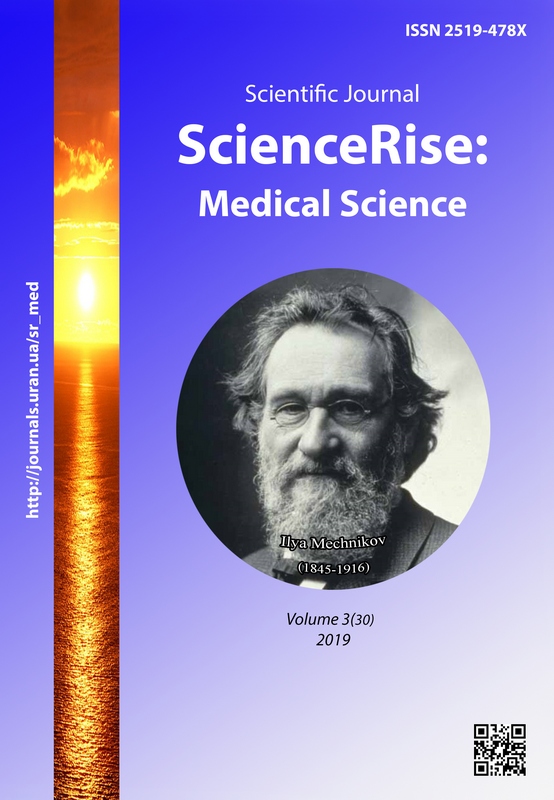Features of existing functional disturbances in patients with chronic obstructive pulmonary disease stage II in the process of integrated therapy with the use of tiotropium bromide
DOI:
https://doi.org/10.15587/2519-4798.2019.171024Keywords:
chronic obstructive pulmonary diseases, tiotropium bromide, external respiratory function.Abstract
The peculiarities of the disturbances of external respiratory function (ERF) in patients with the second stage of COPD, who received tiotropium bromide are presented.
The aim of the study. To evaluate the effect of the baseline therapy of COPD II degree of bronchial obstruction with the use of tiotropium bromide preparation on the parameters of external respiration.
Materials and methods. We examined 151 patients with the second stage of COPD. Verification of the diagnosis and its formulation were performed on the basis of the order of the Ministry of Health of Ukraine No. 555 dated June 27, 2013 "On Approval and Implementation of Medical-Technological Documents on Standardization of Medical Assistance in Chronic Obstructive Pulmonary Disease". The examination was perfomed prior to and on the 30th, 90th and 180th days of standard treatment combined with tiotropium bromide.
Research results. The analysis of aggregate results showed that the highest efficacy was observed in patients who took tiotropium bromide during 180 days, for in this very period external respiratory function parameters maximally increase. Consequently, such a pronounced effect of the used drug tiotropium bromide as a composite basic treatment for stabilizing the function of external respiration in chronic obstructive pulmonary disease II degree, in our opinion, is due to the mechanism of action characteristic of the drug chosen by us, namely, the clear prolonged bronchodilator effect.
Conclusions. Our treatment regimens have a pronounced influence on a number of important pathogenetic links in the course and progression of chronic obstructive pulmonary disease, especially in the initial stages, which clearly confirms the need for early detection of this pathology and early onset of its therapy. They are characterized by simplicity and accessibility, high clinical efficacy, the absence of adverse reactions and complications.
References
- Pro zatverdzhennya ta vprovadzhennya medyko-tekhnolohichnykh dokumentiv zi standartyzatsiyi medychnoyi dopomohy pry khronichnomu obstruktyvnomu zakhvoryuvanni lehen (2013). Nakaz MOZ Ukrayiny No. 555. 27.06.2013. Available at: https://zakon.rada.gov.ua/rada/show/v0555282-13
- Feshchenko, Yu. I., Yashyna, L. O., Dzyublyk, O. Ya. et. al. (2013). Khronichne obstruktyvne zakhvoryuvannya lehen: etiolohiya, patohenez, klasyfikatsiya, diahnostyka, terapiya (proekt natsionalnoyi uhody). Ukrayinskyi pulmonolohichnyy zhurnal, 3, 7–12.
- The First Comprehensive Survey on respiratory health in EUROPE (2003). European Lung WHITE BOOK, 325–397.
- Tolokh, O. S. (2017). Khronichne obstruktyvne zakhvoryuvannyalehen: novi rishennya starykh problem. Klinichna imunolohiya. Alerholohiya. Infektolohiya, 1 (98), 16–22. Available at: https://kiai.com.ua/ua-issue-article-1387/Hronichne-obstruktivne-zahvoryuvannya-legen-novi-rishennya-starih-problem
- Ostrovskyi, M. M. (2016). Khronichne obstruktyvne zakhvoryuvannya lehen: novi vidtinky problemy. Astma i alerhiya, 4, 52–54.
- Decramer, M., Celli, B., Tashkin, D. P., Pauwels, R. A., Burkhart, D., Cassino, C., Kesten, S. (2004). Clinical Trial Design Considerations in Assessing Long‐Term Functional Impacts of Tiotropium in COPD: The Uplift Trial. COPD: Journal of Chronic Obstructive Pulmonary Disease, 1 (2), 303–312. doi: http://doi.org/10.1081/copd-200026934
- Alagha, K., Palot, A., Sofalvi, T., Pahus, L., Gouitaa, M., Tummino, C. et. al. (2014). Long-acting muscarinic receptor antagonists for the treatment of chronic airway diseases. Therapeutic Advances in Chronic Disease, 5 (2), 85–98. doi: http://doi.org/10.1177/2040622313518227
- Anzueto, A., Vogelmeier, C., Kostikas, K., Mezzi, K., Fucile, S., Bader, G. et. al. (2017). The effect of indacaterol/glycopyrronium versus tiotropium or salmeterol/fluticasone on the prevention of clinically important deterioration in COPD. International Journal of Chronic Obstructive Pulmonary Disease, 12, 1325–1337. doi: http://doi.org/10.2147/copd.s133307
- Vogelmeier, C. F., Criner, G. J., Martinez, F. J., Anzueto, A., Barnes, P. J., Bourbeau, J. et. al. (2017). Global Strategy for the Diagnosis, Management, and Prevention of Chronic Obstructive Lung Disease 2017 Report: GOLD Executive Summary. Archivos de Bronconeumología, 53 (3), 128–149. doi: http://doi.org/10.1016/j.arbr.2017.02.001
- Global Initiative for Chronic Obstructive Lung Disease (GOLD) (2017). Global Strategy for the Diagnosis, Management and Prevention of COPD. Available at: http://goldcopd.org/
- Yu, W. C., Fu, S. N., Tai, E. L., Yeung, Y. C., Kwong, K. C., Chang, Y. et. al. (2013). Spirometry is underused in the diagnosis and monitoring of patients with chronic obstructive pulmonary disease (COPD). International Journal of Chronic Obstructive Pulmonary Disease, 8, 389–395. doi: http://doi.org/10.2147/copd.s48659
- Wedzicha, J. A., Decramer, M., Ficker, J. H., Niewoehner, D. E., Sandström, T., Taylor, A. F. et. al. (2013). Analysis of chronic obstructive pulmonary disease exacerbations with the dual bronchodilator QVA149 compared with glycopyrronium and tiotropium (SPARK): a randomised, double-blind, parallel-group study. The Lancet Respiratory Medicine, 1 (3), 199–209. doi: http://doi.org/10.1016/s2213-2600(13)70052-3
Downloads
Published
How to Cite
Issue
Section
License
Copyright (c) 2019 Mariana Kulynych-Miskiv, Mykola Ostrovskyy, Iryna Savelikhina, Kseniya Ostrovska, Oleksander Varunkiv

This work is licensed under a Creative Commons Attribution 4.0 International License.
Our journal abides by the Creative Commons CC BY copyright rights and permissions for open access journals.
Authors, who are published in this journal, agree to the following conditions:
1. The authors reserve the right to authorship of the work and pass the first publication right of this work to the journal under the terms of a Creative Commons CC BY, which allows others to freely distribute the published research with the obligatory reference to the authors of the original work and the first publication of the work in this journal.
2. The authors have the right to conclude separate supplement agreements that relate to non-exclusive work distribution in the form in which it has been published by the journal (for example, to upload the work to the online storage of the journal or publish it as part of a monograph), provided that the reference to the first publication of the work in this journal is included.









